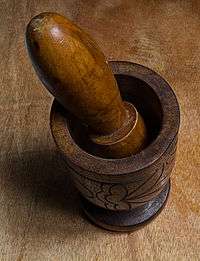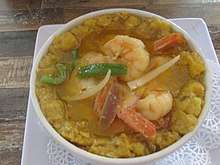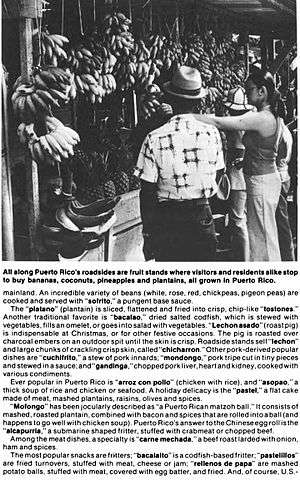Mofongo
Mofongo (Spanish pronunciation: [moˈfoŋɡo]) is a Puerto Rican dish with fried plantains as its main ingredient.[1] Plantains are picked green and fried, then mashed with salt, garlic, broth, and olive oil in a wooden pilón (mortar and pestle).[2][3] The goal is to produce a tight ball of mashed plantains that will absorb the attending condiments and have either pork cracklings (chicharrón) or bits of bacon inside. It is traditionally served with fried meat and chicken broth soup.[4] Particular flavors result from variations that include vegetables, chicken, shrimp, beef, or octopus packed inside or around the plantain orb.
 Mofongo | |
| Course | Main course |
|---|---|
| Place of origin | Puerto Rico |
| Serving temperature | Hot |
| Main ingredients | Plantains, chicharrón, olive oil, and garlic |
| Variations | Fufu, Tacacho, Cayeye, Mangú |
| Other information | Popular throughout: Puerto Rico Dominican Republic New Jersey Florida New York City Boston |
Origins
Mofongo's roots lead to the West African fufu, mixed with some Spanish and Taíno influences. Fufu is made from various starchy vegetables and was introduced to the Caribbean by Africans in the Spanish New World colonies such as Cuba (fufu de plátano), Dominican Republic (mangú), and Puerto Rico (mofongo) this also most likely includes Colombia (cayeye), Amazon region and Peru (tacacho).
Mofongo first appeared in Puerto Rico's first cookbook, El Cocinero Puertorriqueño, in 1859.[5]
In the same cookbook there are recipes for roasted mashed green and yellow plantains with butter, garlic and pork lard. Another is funche made with boiled mashed plantains, taro, pork lard served with sesame seed broth.
Culture
Mofongo evolved from fufu using the African method with vegetation available in the Caribbean. Plantains are most often used, but other starchy roots native to the island used by Taínos can also be used. Puerto Ricans have an obsession with fried food known collectively as cuchifrito in New York City and Kiosks in Puerto Rico. Spanish ingredients such as pork, garlic, broth, and olive oil are commonly used together in Puerto Rican cuisine and are found in staple dishes such as arroz con gandules, alcapurria, pasteles, habichuelas, recaíto, arroz junto, among others. The method of frying comes from the African side and is heavily used more than anyplace in the Caribbean. Broth is often made with chicken and sofrito. Sofrito is made with Spanish and Taíno fruits, vegetables, and herbs.
Method

Plantains and/or starchy roots are cut about half an inch thick and deep-fried. When done, the plantains/roots are crisp outside, but dense inside. The plantains/roots are then mashed in a wooden mortar and pestle called a pilón made with mahogany or guaiacum, both native hardwoods. Broth, olive oil, garlic, and pork cracklings are added and mashed as well. The consistency of mofongo is much more stiff than fufu. In Africa, fufu is accompanied by a bowl of soup. In Puerto Rico, traditionally mofongo is accompanied by chicken broth soup, but braised meat has become more popular.
Variations

It is also common in Puerto Rico to make mofongo with cassava (mofongo de yuca), taro and eddoe (mofongo de malanga y yautía), breadfruit (mofongo de pana), or a combination of cassava, ripe and green plantains (trifongo), ripe and unripe plantains (Bifongo or mofongo de amarillo).
Mofongo stuffed with shrimp (camarón in Spanish) is called camarofongo.
Thanksgiving is an American holiday that has been adopted by Puerto Rico. Turkey is the main focus on every thanksgiving table and is traditional stuffed with bread. The traditional bread stuffing is replaced with mofongo, mofongo de yuca or mofongo de batata (plantain and sweet potato mofongo) in Puerto Rico and Puerto Ricans homes outside the commonwealth. Turkey stuffed with Mofongo can be prepared with seasonings that are traditionally used for pork (garlic, black pepper, oregano, citrus, vinegar and annatto seeds), in which case it can be called "Pavochon."
Frito-Lay produces MoFongo Snax, a combined plantain chips, cassava chips and pork rinds into one bag.
Mofongo relleno is a stuffed variation of mofongo, which, according to Yvonne Ortiz, was first made in "Tino's Restaurant on the west coast of Puerto Rico" when seafood, abundant in the region, was placed inside the plantain ball with braised meat or more seafood poured over it.[6] Nowadays, mofongo relleno is commonly stuffed with either seafood, poultry, or another meat.[7]
Mofongo outside of Puerto Rico

During the 1960s many Dominicans who feared the dictatorship of Rafael Trujillo fled to Puerto Rico and New York City. Mofongo caught on quickly with Dominicans living in Puerto Rico and New York City. Mofongo has become a flagship food for many Dominican restaurants. Moca, Dominican Republic is known for adding chedder cheese.
Bolón de verde is a similar dish in Ecuador. The dish appears much later in Ecuadorian cuisine. Plantains are boiled or roasted, mashed with chicarrón and cheese (queso blanco) formed into balls and fried.
Mofongo has become popular among Colombians, Cubans and Dominicans living in the U.S.A and anywhere large numbers of Puerto Ricans or Dominicans reside.
Mofongo has become popular in high end Latin restaurants and Pan-Latin restaurants. Mofongo with Peruvian ceviche, South American churrasco and chimichurri, Cuban ropa vieja, Colombian ajiaco, Méxican salsa verde and meat and so on.
Debate
Around early 2000s Mofongo became very popular amongst Dominicans. Dominicans have claimed mofongo as theirs and not an import from Puerto Rico.
Clara Gonzalez, also known as Aunt Clara, is a Dominican chef and author. In her cookbook (Tradition Dominican cookery) claims that mofongo has a special place in the Dominicans' hearts and stomachs but can be traced back to Puerto Rico. But she goes on to say that roasted plantains mashed garlic with chicharrón on the side may have been a pre mofongo and may have always been a part of Dominican gastronomic. These recipes come up in Dominican cookbooks in the 60's. They are debunked due to older Puerto Rican cookbooks with roasted mashed plantains with garlic, lard, and pork.
Ramona Hernandez, director of the Dominican Studies Institute of the City University of New York, has been interviewed for many magazines on Dominican food and culture, she also says "mofongo is a dish borrowed from Puerto Rico that has much success with Dominicans".
Both countries, along with Cuba, share much in food, language, music and traditions. Cuban singer Celia Cruz sang a merengue titled "Pun pun catalu" about the similarly among the three islands. She mentions how mashed plantains with chicarrón is fufú in her native Cuba, mangú in Quisqueya (Dominican Republic) and mofongo in Boriken (Puerto Rico).
Mun2 television network aired a show titled "Where does mofongo come from? Puerto Rico or Dominican Republic?" The two hosts went around the streets of New York City asking Latin communities "Where does mofongo come from?" They found that the dish has its roots in African cooking but originated in Puerto Rico.
In popular culture
Food Network chef and host Guy Fieri featured mofongo from Benny's Seafood (in Miami, Florida) and from El Bohio (in San Antonio, Texas) on two separate episodes of his show Diners, Drive-Ins and Dives. He liked the dish so much that he called it the "best fried thing I ever ate" on an episode of the show The Best Thing I Ever Ate.[8]
Anne Burrell is featured in a Season 2 episode of Chef Wanted with mofongo as the opening dish challenge.
Mofongo is also featured in Episode 7, Season 6 of the Food Network show, Beat Bobby Flay, where Bobby Flay's mofongo dish prevails over a mofongo dish prepared by Puerto Rican chef Giovanna Huyke.
An episode of the Travel Channel's Man v. Food Nation, set in Harlem, showed the host Adam Richman visiting a Spanish Harlem restaurant called La Fonda Boricua, where they make a giant 12-plantain mofongo called the Mofongaso.
Perhaps the oldest song mentioning mofongo is called Puertorriqueño by Joe Valle and César Concepción.
Singer Ismael Rivera with conductor Rafael Cortijo sang a plena song called "Mofongo Pelao" about mofongo.
Anthony Bourdain: No Reservations featured mofongo in Season 2, Episode 2: Puerto Rico where Bourdain and his friend Andy Diaz dine on mofongo at the beach. "That is just a tower of goodness," Bourdain says.
On Saturday Night Live, David Ortiz (a recurring impression played by Kenan Thompson) frequently refers to the dish when describing his "big lunch".
See also
References
- Torres, A. (2006). Latinos in New England (in Spanish). Temple University Press. p. 106. ISBN 978-1-59213-418-2. Retrieved 12 November 2019.
- Carballo, Viviana (January 19, 2005). "Gusto! ; Plantains Carry Deep Roots of Tradition in Mofongo". Special to the Sentinel. Orlando Sentinel. Retrieved December 16, 2015.
- Cordero Malavé, Deborah (2010). Plantain Hybrids: Fresh Market and Processing Characteristics. Mayaguez, PR: University of Puerto Rico , Mayaguez Campus. pp. 9, 41.
- Antonio Benítez Rojo (1996). The Repeating: The Caribbean and the Postmodern Perspective. James E. Maraniss (translation). Duke University Press. p. 97. ISBN 0-8223-1865-2.
- Barradas, Efraín (2010). De Maeseneer, Rita; Collard, Patrick (eds.). Saberes y sabores en México y el Caribe (in Spanish). Boston: Brill. p. 269. doi:10.1163/9789042030459. hdl:1854/LU-1013097. ISBN 978-90-420-3045-9.
- Ortiz, Yvonne (1997). A Taste of Puerto Rico: Traditional and New Dishes from the Puerto Rican Community. Plume. ISBN 0452275482.
- Van Atten, Suzanne (2015). Moon San Juan, Vieques & Culebra. Avalon Travel. ISBN 978-1631212284.
- Video: Guy Fieri on Mofongo Archived 2011-11-25 at the Wayback Machine on Food Network